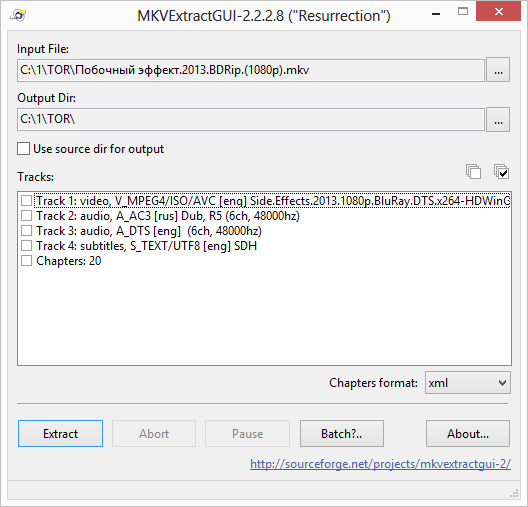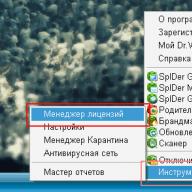As you know, files with the extension mkv is a special multimedia container for storing video, audio paths and subtitles. She is Matryoshka. Below will be described how to work with audio tracks correctly.
It often happens that there are several audio paths and subtitles in a container, and some of them are not needed. For example, roads with an unfamiliar language or several Russians. Or another option, when the sound road has the format dts, which is not always reproduced by "iron" players. It can be recoded to ac3.
I will describe the most optimal, in my opinion, actions for performing these tasks.
You only need two programs.
The first one is Mkvtoolnix for working with mkv containers.
The second - Xilisoft Video Converter Ultimate... Besides coding dts v ac3 has many other useful features.
Take the once popular Slumdog Saints as an example.
Launch mkvmerge GUI from the kit Mkvtoolnix
Choosing a movie and getting something like this:

In addition to the video and subtitles, the container contains four more roads. English, two Russians and a road by Goblin. Here it is exactly what you need. Remove the checkboxes from unnecessary elements, select the final path and the name of the reassembled container and click Start muxing.

After mixing is complete, the new container looks like this. Video and one audio track.

Now it can be recoded into ac3.
Launch Xilisoft Video Converter Ultimate... Add a file, in the Profiles tab, select ac3 and the path to save. Also on the right side of the program, you can change the settings for the encoded track.
We press the red button at the top and wait.

It turned out to be a separate track ac3... Now you need to replace the track with the extension with it. dts... To do this, open the mkvmerge GUI again, select the file mkv with one track dts and add a track with the add button ac3, while from the track dts uncheck the box accordingly.


You ask why all this was needed?
The original file with all tracks weighed 6.56 GB, the final file was 3.78 GB. In addition to the fact that it takes up less space, it can be copied relatively quickly to a USB flash drive and watched from a device that does not support sound in the format dts(for example, SAMSUNG TVs of the sixth series of 2009, which even the new firmware did not help to learn to read dts).
It is not recommended to use mkvmerge versions higher than 4.0.0. This is especially true for owners of Samsung TVs of 2009 release. (2009 is the letter "B" in the model name. For example LE37 B*****) Most of the reassembled containers refuse to run on the built-in player of the above TVs.
UPDATE2:
And how to pull out separate subtitles or an audio track? It's simple. To do this, you need a program MKVExtractGUI... It must be placed in a folder with Mkvtoolnix.

Everything here is intuitively clear: select a file, an output folder and check the boxes required to extract the files from the container.
Recently, a considerable number of films, especially versions processed from a DVD or Blu-ray source, may contain 2 or more sound versions. A high-quality duplicated translation is standardly supplemented by the original, and sometimes by several versions from enthusiasts or other professional translation and dubbing studios. A simple viewer only benefits from such a variety, because now there is a choice - you can also listen to sometimes "insipid" dubbing or the savory style of the Goblin. Most often, to change the audio track in KMPlayer, it is enough to use the CTRL + X keyboard shortcut, all other options are discussed in more detail later in the article.
Types of audio tracks
The sound, or audio track, is of two types - built-in and external. The first is a more convenient option, because all the voiceovers in the video are "wired" into one file and switch faster. The second, on the other hand, makes it more convenient to distribute the translation among users, although video and sound synchronization is required for different files, it connects a little slower.
Adding an external audio track
Launch the desired video file and pause it. Right click in the active KMPlayer window → “Open” → “Load external audio track”. Next, you need to find (usually located in the folder with the movie itself) and select the audio file that we want to connect as an audio track, then click "Open". After completing this procedure, two options are possible: either the external track will connect itself and become active, or it should appear in one of the lists of the "Filters" item (it will become available after clicking RMB in the active KMPlayer window) and you will need to select it already there.
How to change the built-in audio track
The built-in audio track is changed in the "Filters" item (it will become available after clicking RMB in the active KMPlayer window). Then there are two options, depending on the default splitter. If Matroska is active, then you should look for a list called "KMP Matroska Reader", if LAV Splitter - we are looking for an item with a corresponding name, there will be a list of available audio tracks with the ability to select the option you need.

Russian audio tracks by default
In the latest versions of KMPlayer, a rule is hardcoded in the settings, which gives priority to voiceovers in English. As a result, you have to switch tracks yourself each time. This rule can and should be changed. To do this, go to the player's settings using the F2 hotkey. In the vertical block on the left we find the item "Subtitle processing" and select the sub-item "Languages / Speech". Next, we edit the line "Preferred subtitle language", in the end there should be two words rus ru. In other words, we made it so that audio tracks containing the abbreviations rus or ru have priority over the rest. To set a different priority of languages, for example, Russian, Japanese, English, one could write rus jpn eng. Now it remains to click the "Close" button at the bottom right of the window and the settings are saved.

Almost all films on this site have 2 audio tracks, English and Russian. If you're lucky, you can watch movies online on your gadget. There will be English and subtitles (worth the 1st track). In order to switch audio tracks, you need to download the movie to your PC. You can switch the audio track only for those video files that have these two tracks! Most popular players (except for the standard Windows Media Player) make switching between tracks easy, in 2-3 clicks.
The logic is simple everywhere. It is necessary to find the item in the menu Sound (Audio) then choose, that is put a tick on the desired Track (Stream)... Be careful, if you select two tracks, it is possible that two channels of sound will be played back at once. You can download players anywhere. Most of them are free.
This is a standard player included in the Windows operating system. Very uncomfortable. I do not recommend watching video files in this player, in most cases the player is simply cannot switch audio tracks... You can try to do it as shown in the picture:
One of the best. Free for Russian-speaking users. It is only necessary to answer the riddle correctly when registering :).
Right-click and in the menu that appears, select Sound -> Switch audio track.

Or below, right after "Volume" click sound icon and in the panel that appears, select the desired track.

Go to the menu Play -> Audio ->

A full set of built-in codecs, convenient management and complete free of charge. If you need to change the audio track, click CTRL + X and the soundtrack will change.
Another way is to press right button and in the appeared select a soundtrack from the menu, as shown in the figure.

VLC Media PlayerVLC Media Player
Excellent and lightweight player. Can play streaming video. It is recommended for use in Sopcast. Go to the menu Audio -> Audio Track and select the audio track you want.

Bsplayer
Right-click, in the menu that appears, select the item Audio -> Audio Streams and click on the audio track you need.
There are many programs for playing video, and the methods for selecting the audio track vary. In some players, the settings are intuitive, in others - everything is not so obvious. Therefore, we will select the most popular players and describe in detail how to change audio tracks in them.
Windows Media Player. One of the most common players has rather limited functionality. In some cases, you will not be able to switch the track - in this case, download and install a more advanced player. But still, try pressing Ctrl + S after starting the video. This will stop playback. Right-click on the player screen and select Sound & Duplicated Tracks. There should be a list of voices here. Oddly enough, every time you switch between tracks, Windows Media Player needs to be restarted. VLC Media Player. Right-click on the player screen, select the "Audio" - "Audio track" option. Select the desired track from the list of tracks provided. Another way is to go to the "Audio" section of the player, which is at the top of VLC, find "Audio" and set the track. Media Player Classic (MPC). Go to the "Play" tab, find "Audio" and set the track. An even easier way is to right-click on the player's screen, point to Audio from the list of options and select a track. Light Alloy. Press Shift + A and you will find yourself in the sound settings. At the very bottom of the window, select a track from the drop-down list. By right-clicking on the speaker icon on the player screen, you can also select a track - they will all be displayed at the very bottom of the list of sound settings. BSPlayer. This player is notable for the fact that it detects and installs the missing video codecs for normal playback. To change the track, right-click on any area of the player, designate "Audio" - "Audio streams", and then the track marked as "stream". KMPlayer. To change the track, press the CTRL + X combination or right-click on the player and select "Audio" - "Select stream" - the desired stream.





As you can see from the article, changing the audio track is quite simple. The exception is simple programs with weak functionality, for example, Windows Media Player, or limited to work with audio files, such as Winamp. Remember to keep your players up to date and download the latest video codec sets to avoid problems with playback and audio settings.
In the life of every video editing lover, there comes a time when it is time to learn not only video effects, but also audio - how to change audio track... And sometimes it is a necessity, if the sound in the video leaves much to be desired and needs to be replaced. Or you want to add a special piquancy or zest to the video sequence, for example, the effect of an echo, an assembly hall, the feeling of a room, and more.
Sony Vegas video editing software is like no other suitable for this type of work, moreover, even a beginner can easily master it.
So, our today's lesson will be devoted to editing audio tracks in Sony Vegas. And we'll cover four basic basic tricks.
1. Removing and replacing audio.
This technique is needed in order to replace existing audio with something else (for example, instead of drunken trills of guests at a wedding, substitute Verka Serduchka's hit or simply delete it.
Open the project, load the desired video fragment into it and drag it to the work area. If you drag this video around the work area with the mouse, you will notice that both video and audio go together inseparably. And it does not depend on whether you drag the mouse for a piece of video or for a piece of audio.

Accordingly, if you try in this case with the key DELETE delete the audio track, then the entire movie will be deleted along with the video. To prevent this from happening, you need to "break" the video and audio. To do this, click on the video and press the " U ". Then, dragging the video with the mouse again, you will see that it is already moving separately from the audio track. After that, we simply delete it and, if desired, put another one.

2. Change the sound level.
This technique helps to make sound jumps from loud to quiet, when at a certain moment the sound needs to be muted or, on the contrary, raised its level. So, for this we go to the menu items Insert ->AudioEnvelopes ->Volume or use hotkeys Shift + V.

Then we return to our video, or rather to the audio track that belonged to him. Double-click the mouse to place marks in the places where we will adjust the sound.

Then, by pressing these marks and moving them, you can raise or lower the sound level. Listen to what happened, it might be funny.

You can also create an effect that I call “ Left ear - Right ear". It assumes the sound of audio in the left speaker, then in the right. To do this, go to the menu items Insert ->AudioEnvelopes ->Pan or press the burning keys Shift + P.

Again, on the audio track, put marks in several places where we want to apply the audio effect.

And, as in the previous case, using the labels, we adjust where the audio will fall to " left ear", And where - on" right ear».

3. Special audio effects
Sony Vega s has its own set of audio effects that will help to embellish the sound of the video. To find them, go to the menu items View ->Plug-inManager .

A window opens to our eyes with a variety of audio effects for every taste.

To use one of them, you need to drag the selected one onto our audio track with the mouse and set the necessary characteristics.

4. Slow-motion sound
To "stretch" the audio sound (in English - slowmotion), you need to select the desired video, if necessary, "cut" the piece that will be edited (for this, the cursor clicks on the video in the place where you want to make the "cut", and click key " S"). And then the desired piece is pulled to the side.

And then we hold down the key CTRL and drag the video by the edge, thus stretching it. So much for slow motion and sound.

This lesson was prepared as part of a free training course "How to Create Your Own Home Video Masterpiece", to subscribe to which you can:
- specify your Name and your EMail in the right column of the blog and click the "Get a Course" button;
- by clicking on the link.
I hope this tutorial was helpful and will help you improve your video editing skills.
And for today I have everything.
Good luck and see you soon!




